LG Electronics USA LM505F 15- Inch LCD Monitor User Manual EMISSION TEST REPORT
LG Electronics USA 15- Inch LCD Monitor EMISSION TEST REPORT
Users Manual

A1
This unit has been engineered and manufactured to ensure your personal
safety, however improper use may result in potential e shock or fire hazards.
In order to allow the proper operation of all safeguards incorporated in this
display, observe the following basic rules for its installation, use, and
servicing.
On Safety
Use only the power cord supplied with the unit. In case you use another power
cord, make sure that it is certified by the applicable national standards if not being
provided by the supplier. If the power cable is faulty in any way, please contact the
manufacturer or the nearest authorized repair service provider for a replacement.
The power supply cord is used as the main disconnection device. Ensure that the
socket-outlet is easily accessible after installation.
Operate the display only from a power source indicated in the specifications of
this manual or listed on the display. If you are not sure what type of power supply
you have in your home, consult with your dealer.
Overloaded AC outlets and extension cords are dangerous. So are frayed power
cords and broken plugs. They may result in a shock or fire hazard. Call your service
technician for replacement.
Do not Open the Display.
There are no user serviceable components inside.
There are Dangerous High Voltages inside, even when the power is OFF.
Contact your dealer if the display is not operating properly.
To Avoid Personal Injury :
Do not place the display on a sloping shelf unless properly secured.
Use only a stand recommended by the manufacturer.
To Prevent Fire or Hazards:
Always turn the display OFF if you leave the room for more than a short period
of time. Never leave the display ON when leaving the house.
Keep children from dropping or pushing objects into the display's cabinet
openings. Some internal parts carry hazardous voltages.
Do not add accessories that have not been designed for this display.
During a lightning storm or when the display is to be left unattended for an
extended period of time, unplug it from the wall outlet.
Important Precautions

A2
Important Precautions
On Installation
Do not allow anything to rest upon or roll over the power cord, and do not place
the display where the power cord is subject to damage.
Do not use this display near water such as near a bathtub, washbowl, kitchen
sink, laundry tub, in a wet basement, or near a swimming pool.
Displays are provided with ventilation openings in the cabinet to allow the release
of heat generated during operation. If these openings are blocked, built-up heat
can cause failures which may result in a fire hazard. Therefore, NEVER:
Block the bottom ventilation slots by placing the display on a bed, sofa, rug, etc.
Place the display in a built-in enclosure unless proper ventilation is provided.
Cover the openings with cloth or other material.
Place the display near or over a radiator or heat source.
Do not rub or strike the Active Matrix LCD with anything hard as this may scratch,
mar, or damage the Active Matrix LCD permanently.
Do not press the LCD screen with your finger for a long time as this may cause
some afterimages.
Some dot defects may appear as Red, Green or Blue spots on the screen.
However, this will have no impact or effect on the display performance.
If possible, use the recommended resolution to obtain the best image quality for
your LCD display. If used under any mode except the recommended resolution,
some scaled or processed images may appear on the screen. However, this is
characteristic of the fixed-resolution LCD panel.
On Cleaning
Unplug the display before cleaning the face of the display screen.
Use a slightly damp (not wet) cloth. Do not use an aerosol directly on the display
screen because over-spraying may cause electrical shock.
On Repacking
Do not throw away the carton and packing materials. They make an ideal
container in which to transport the unit. When shipping the unit to another
location, repack it in its original material.
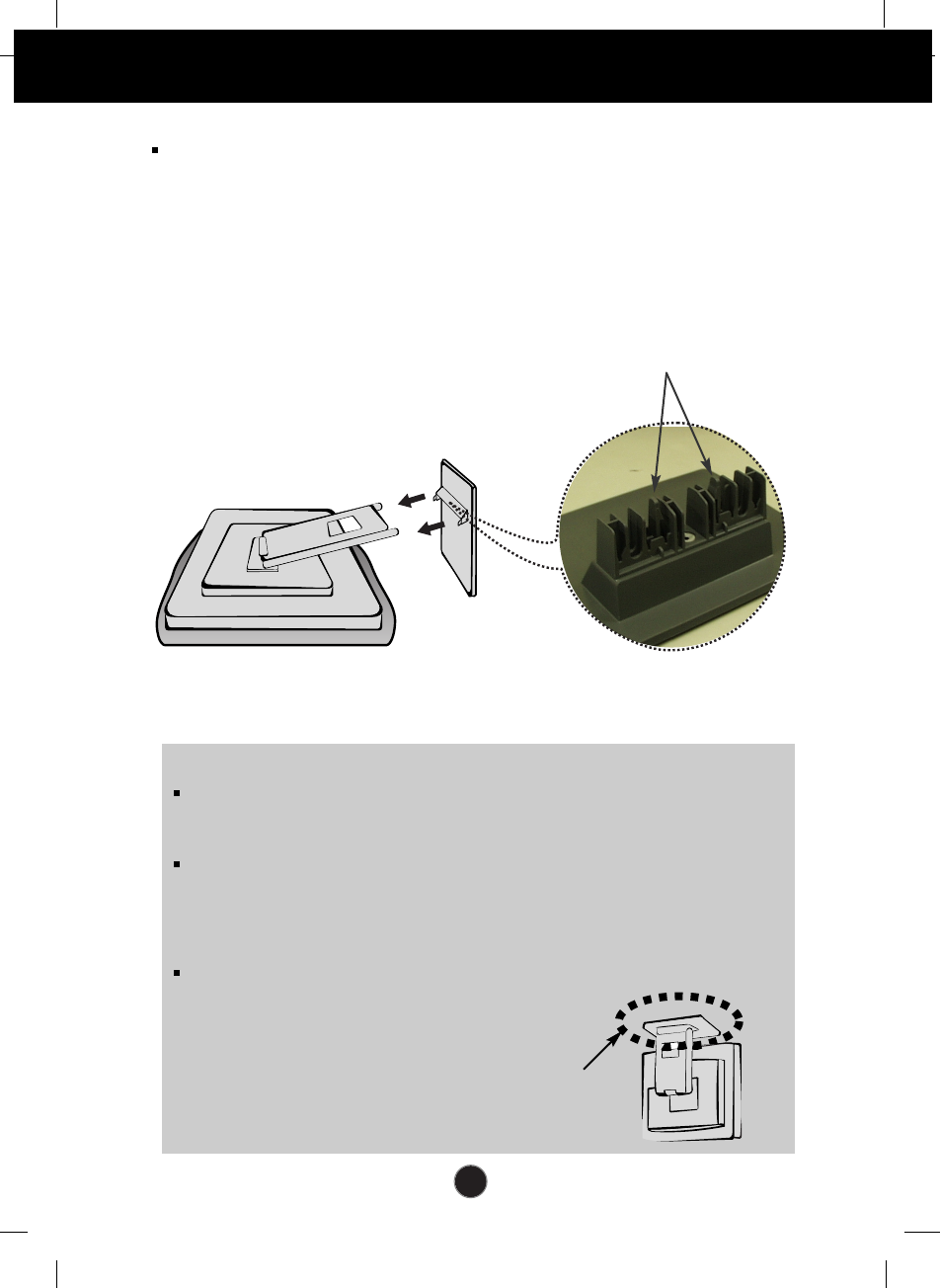
A3
Connecting the Display
Before setting up the monitor, ensure that the power to the monitor, the
computer system, and other attached devices is turned off.
Connecting the stand base
1. Align the hooks on the stand base with the matching slots in the base of
the monitor.
2. Insert the hooks into slots.
Important
This illustration depicts the general model of connection. Your monitor may
differ from the items shown in the picture.
To Remove the Stand Base
- Do not force to remove the Stand Base, but remove the screws on the
back first for your safety.
- Once you connect the stand base, try not to disconnect it.
Do not carry the product upside down holding only
the stand base. The product may fall and get
damaged or injure your foot.
Hook
Stand Base
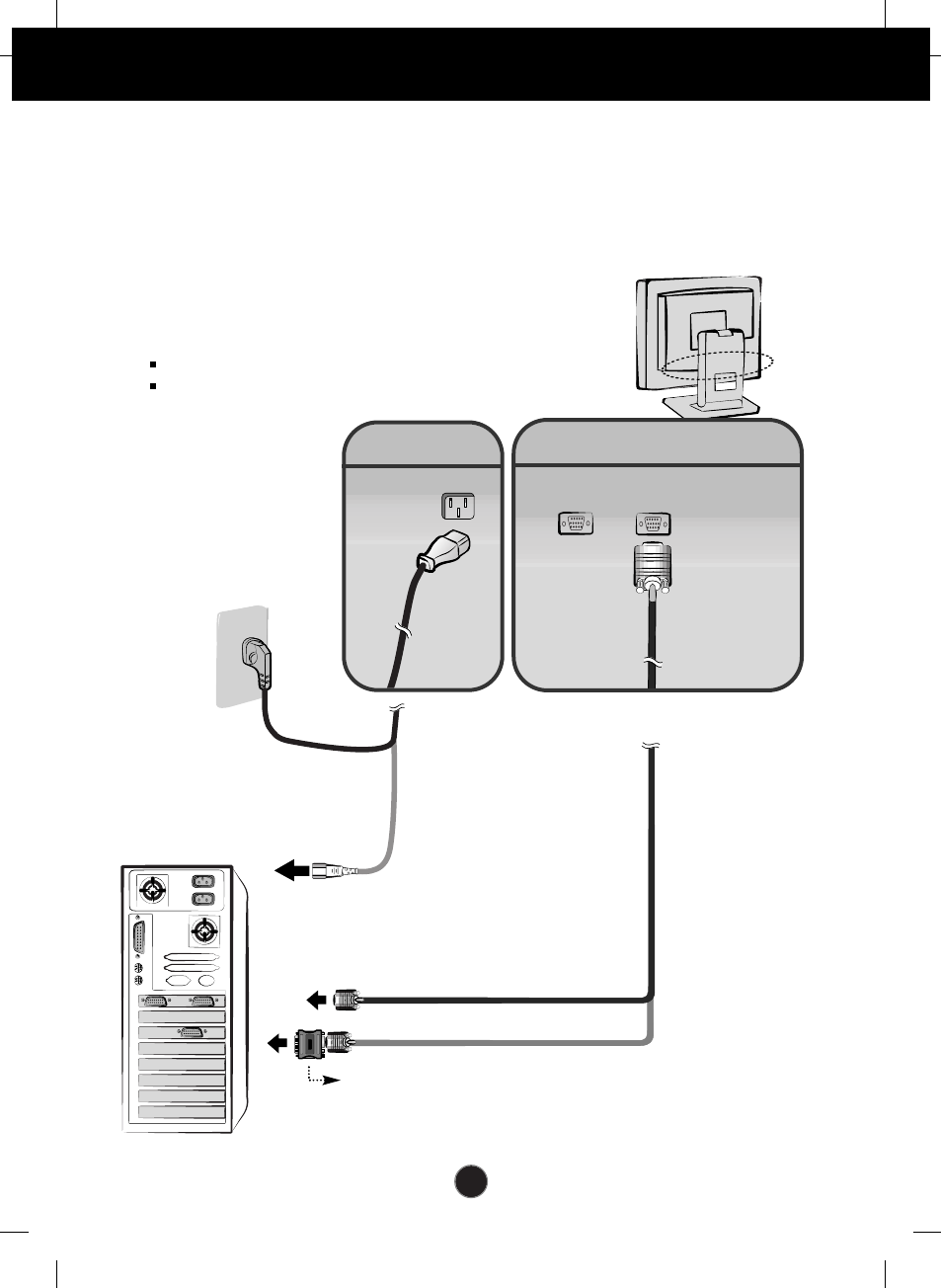
A4
Connecting the Display
Using the Computer
1. Connect the signal cable. When attached, tighten the thumbscrews to secure
the connection.
2. Connect the power cord into a proper power outlet that is easily accessible and
close to the display.
Mac adapter
For Apple Macintosh use, a separate plug adapter is needed to
change the 15 pin high density (3 row) D-sub VGA connector
on the supplied cable to a 15 pin 2 row connector.
Wall-outlet type*
NOTE
This is a simplified representation of the rear view.
This rear view represents a general model; your display
may differ from the view as shown.
PC-outlet type*
PC
MAC
Power Cord Signal Cable
Analog signal
D-sub*
*
Varies according to model.
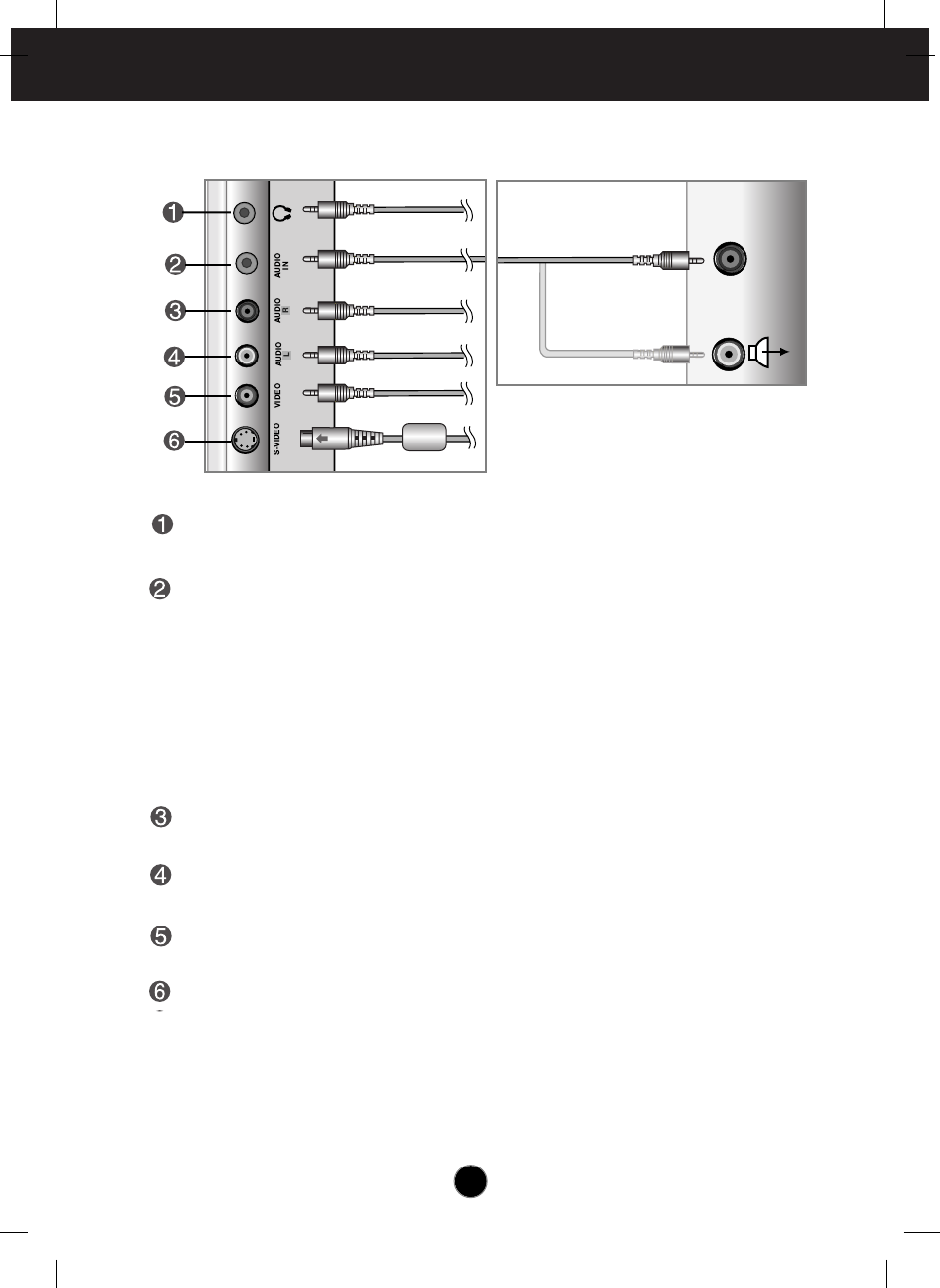
Connecting the Display
A5
Side Jacks
*LINE OUT
A terminal used to connect to the speaker including a built-in amplifier (Amp). Make sure that the
connecting terminal of the PC sound card is checked before connecting. If the Audio Out of PC
sound card has only Speaker Out, reduce the PC volume.
If the Audio Out of the PC sound card supports both Speaker Out and Line Out, convert to Line
Out using the card jumper of the program (Refer to the Sound Card Manual).
Headphone/Earphone Input
Automatically mutes the speaker volume when the headphones are plugged in.
Audio Input
Connects to the *LINE OUT jack of the PC sound card.
VCR/DVD Audio(R) Input
Connects to the Audio(R) jack of the VCR/DVD.
VCR/DVD Audio(L) Input
Connects to the Audio(L) jack of the VCR/DVD.
VCR/DVD Video Input
Connects to the Video jack of the VCR/DVD.
VCR/DVD S-Video Input
Connects to the S-Video jack of the VCR/DVD.
Display
*Line Out
Speaker Out
Jack of the PC sound card
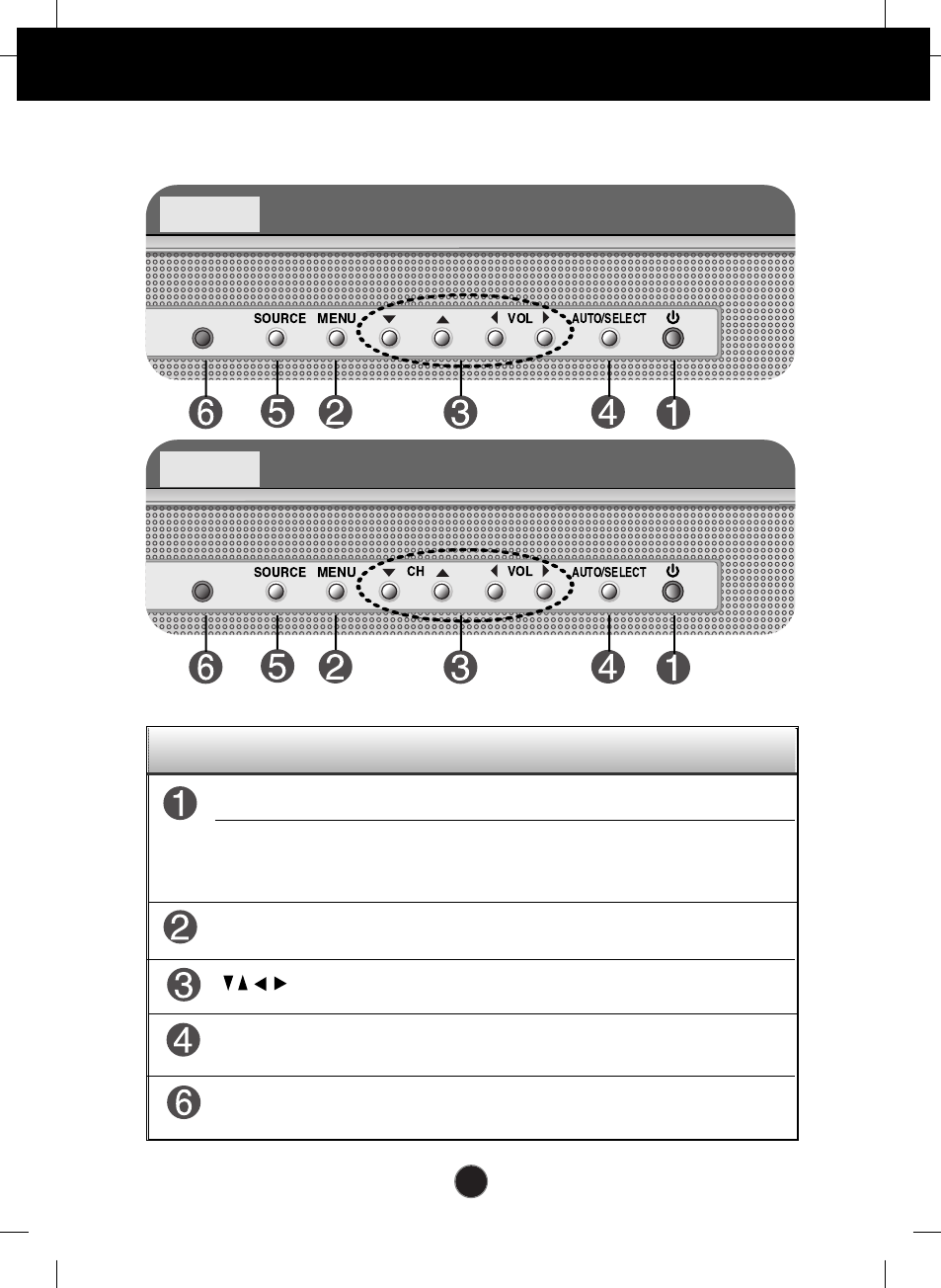
A6
Control Panel Functions
Front Panel Controls
Buttons
Use these buttons to choose or adjust items in
the On Screen Display.
MENU Button
Use this button to enter or exit the On Screen
Display.
Use this button to turn the display on or off.
This Indicator lights up green when the display
operates normally. If the display is in DPM (Energy
Saving) mode, this indicator color changes to amber.
Power Button
Power (DPMS)
Indicator
Use this button to enter a selection in the On Screen
Display.
AUTO/SELECT
Button
Control Function
L1510A
L1510T
Remote Control Sensor
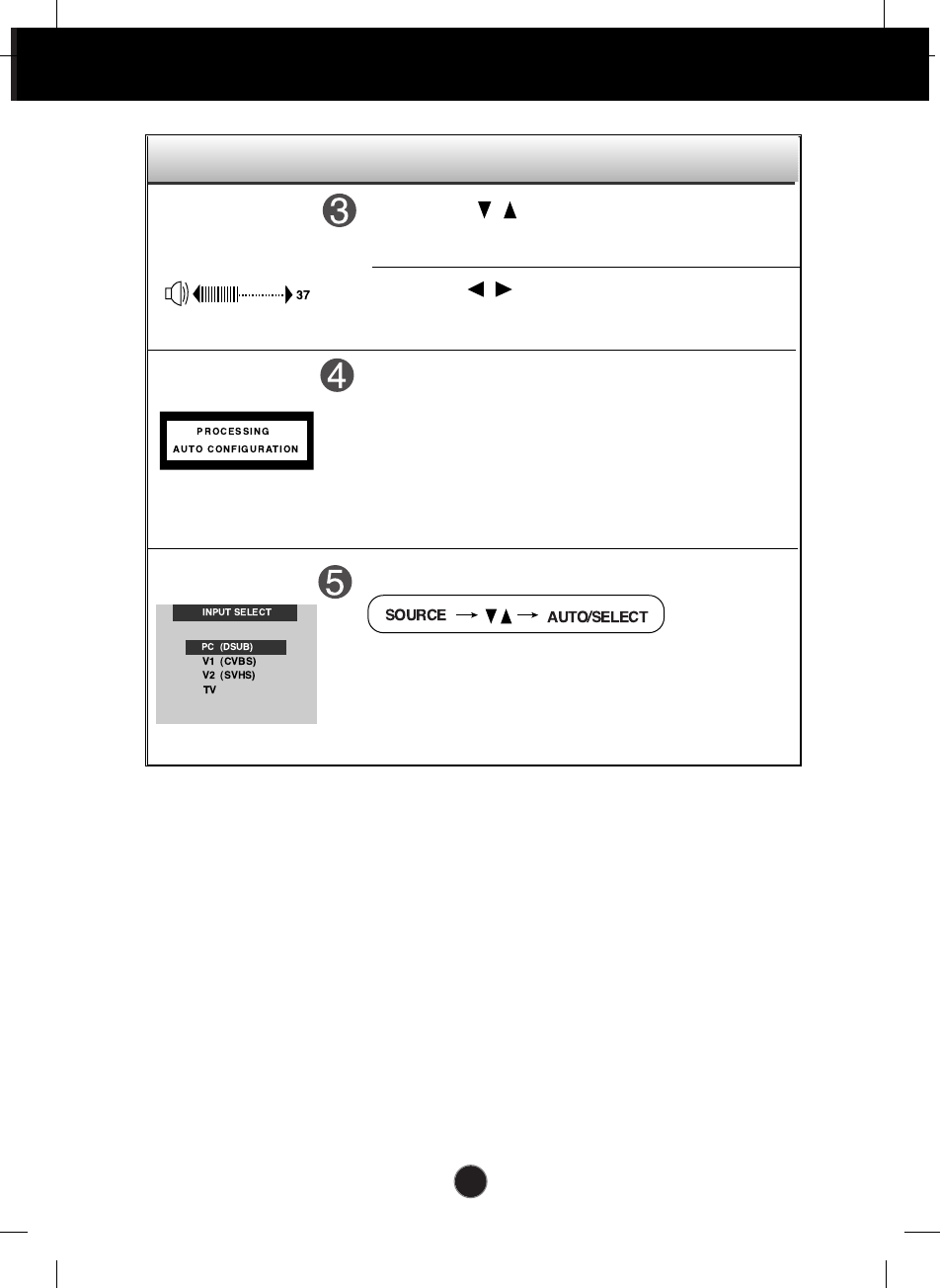
A7
Control Panel Functions
Control Direct Access Function
When adjusting your display settings, always press the
AUTO/SELECT button before entering the On Screen
Display(OSD). This will automatically adjust your display
image to the ideal settings for the current screen
resolution size (display mode).
The best display mode is 1024x768.
AUTO adjustment function
Use these buttons to decrease or increase the volume level.
VOLUME:
Use these buttons to go up and down the channel
when the TV source is available.
CHANNEL:
Use this button to select an input signal.
• PC (DSUB) : 15-pin D-sub analog signal
• V1 (CVBS) : Composite video
• V2 (SVHS) : S video
• TV: TV
Source Selection:
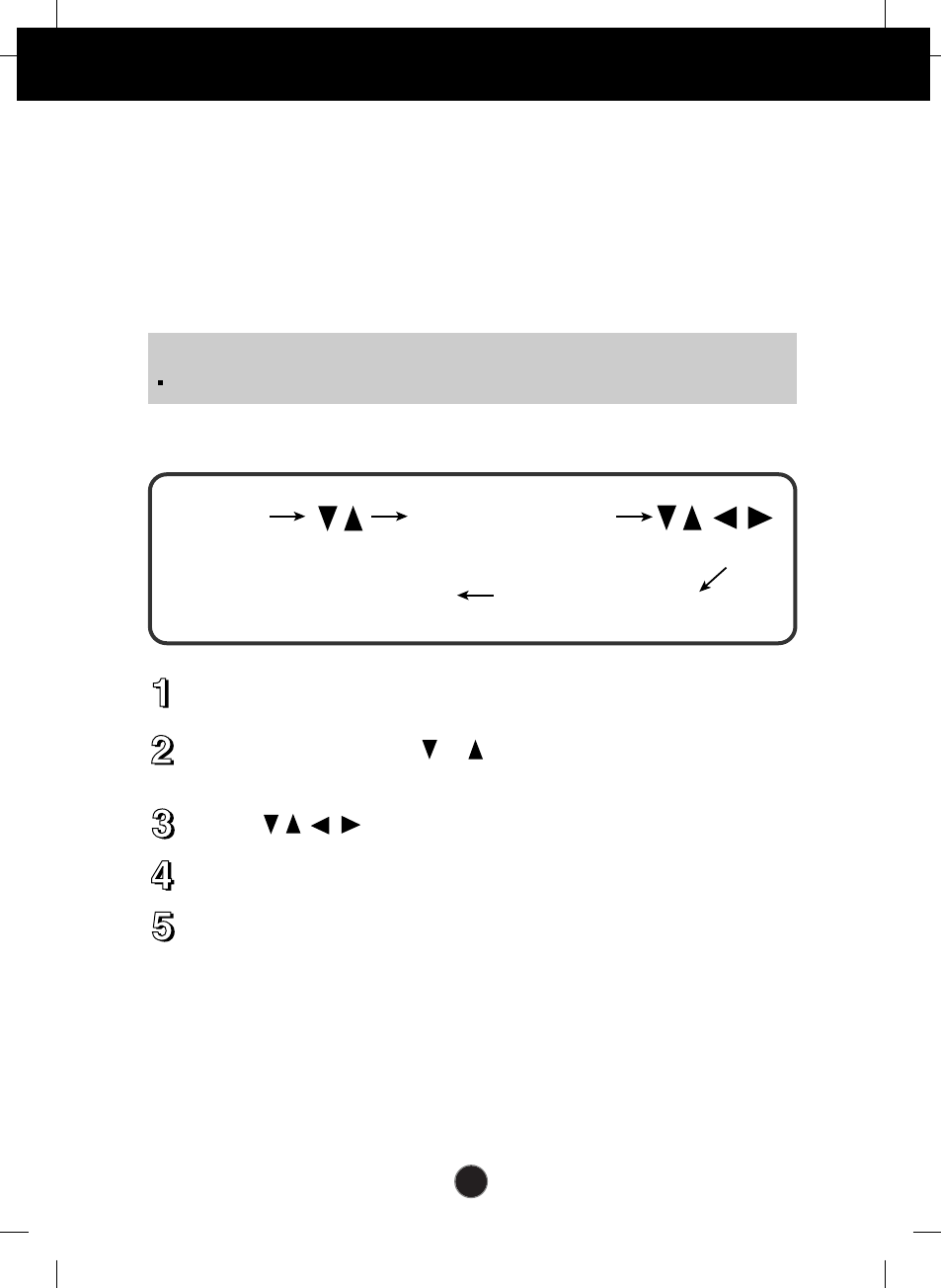
A8
On Screen Display (OSD) Control Adjustment
Screen Adjustment
Making adjustments to the image size, position and operating parameters of
the display is quick and easy with the On Screen Display Control system. A
short example is given below to familiarize you with the use of the controls.
The following section is an outline of the available adjustments and selections
you can make using the OSD.
To make adjustments in the On Screen Display, follow these steps:
Press the MENU Button, then the main menu of the OSD appears.
To access a control, use the or Buttons. When the icon you want
becomes highlighted, press the AUTO/SELECT Button.
Use the Buttons to adjust the item to the desired level.
Accept the changes by pressing the AUTO/SELECT Button.
Exit the OSD by Pressing the MENU Button.
NOTE
Allow the display to stabilize for at least 30 minutes before making image adjustments.
AUTO/SELECT
AUTO/SELECT
MENU
MENU
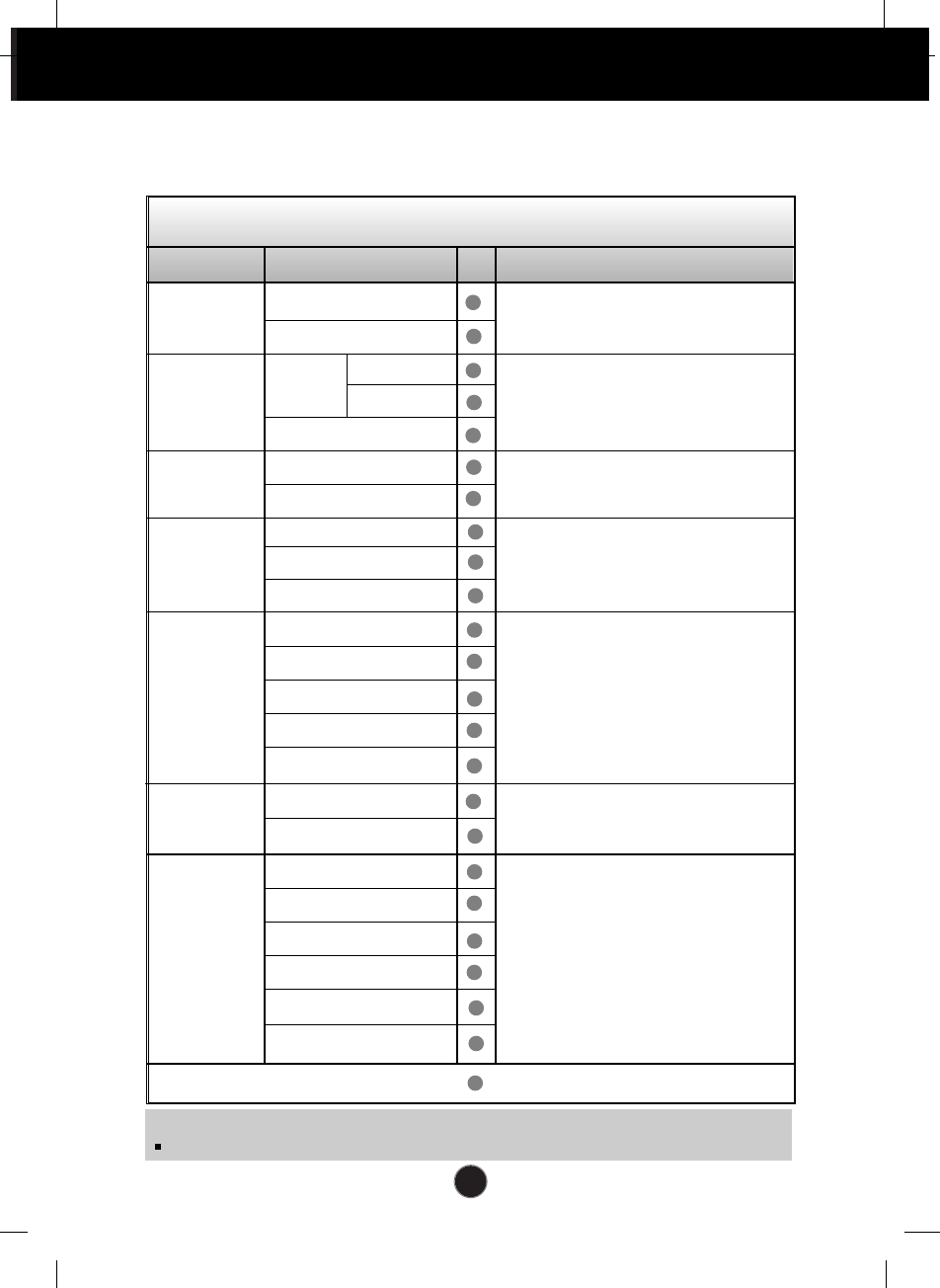
A9
NOTE
The order of icons may differ depending on the model (A9~A13).
On Screen Display(OSD) Selection and Adjustment
The following table indicates all the On Screen Display control, adjustment,
and setting menus.
To adjust the brightness and
contrast of the screen
BRIGHTNESS
CONTRAST
COLOR
POSITION
TRACKING
AUDIO
SETUP
PIP
Using the computer
Main menu Sub menu Reference
PRESET
9300K
6500K
R/G/B(User Color)
To adjust the position of the
screen
To customize the color of the
screen
To customize the screen status
for a user's operating environment
To improve the clarity and
stability of the screen
: Adjustable
BRIGHTNESS
CONTRAST
V POSITION
H POSITION
AUTO
CLOCK
PHASE
LANGUAGE
OSD POSITION
To adjust the audio function
VOLUME
MUTE
BASS
TREBLE
BALANCE
To adjust the PIP of the screen
PIP ON/OFF
PIP SOURCE
PIP SIZE
PIP SOUND
PIP POSITION
TRANSPARENCY
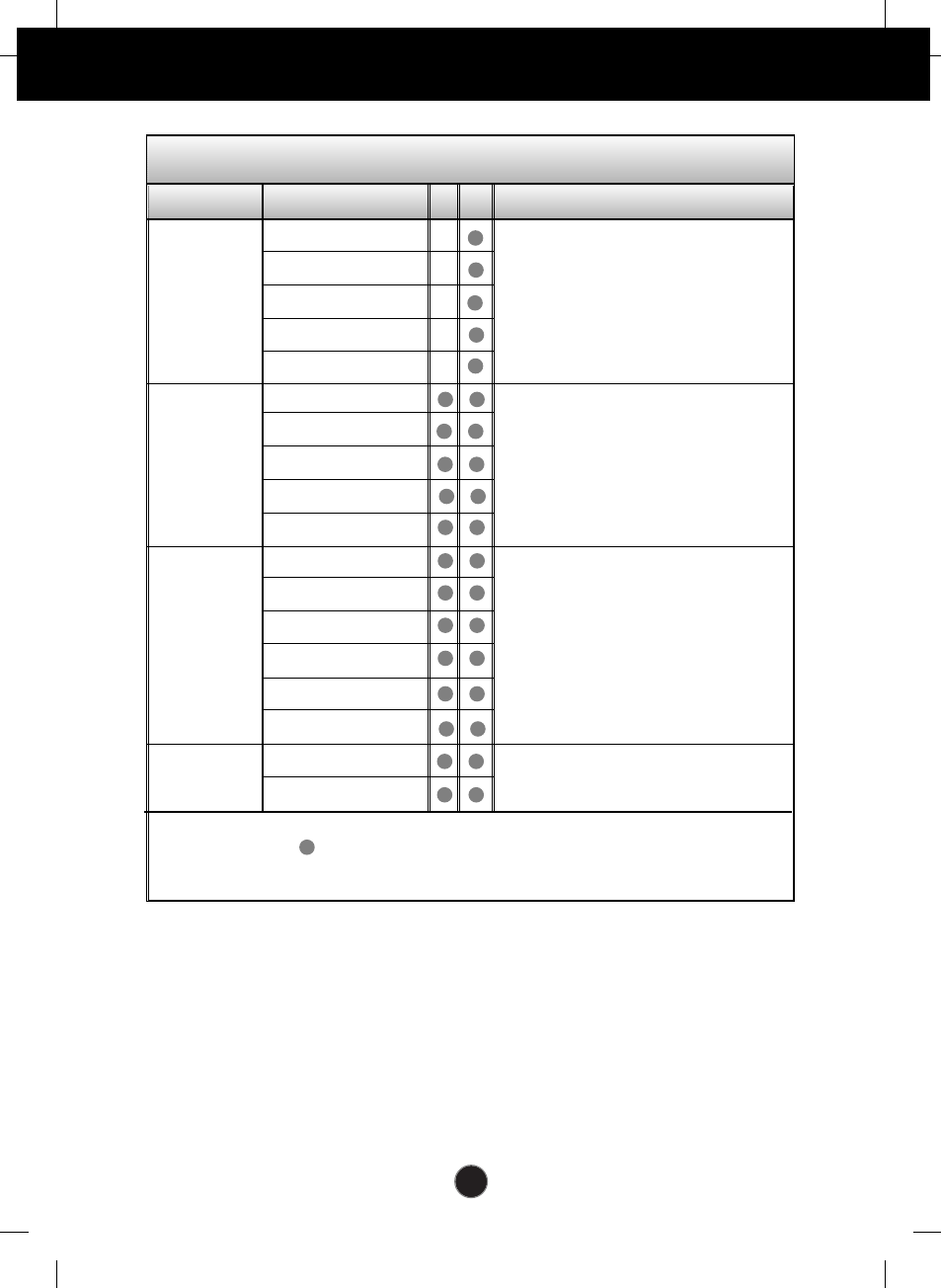
A10
On Screen Display(OSD) Selection and Adjustment
CHANNEL
VIDEO
AUDIO
SETUP
Main menu Sub menu V T Reference
CONTRAST
BRIGHTNESS
SHARPNESS
COLOR
TINT
To customize the screen status
for a user's operating environment
To improve the clarity and
stability of the screen
LANGUAGE
OSD POSITION
To adjust the audio function
VOLUME
MUTE
BASS
TREBLE
BALANCE
SOUND
CHANNEL MODE
AUTO CHANNEL
MANUAL CHANNEL
ADD/DELL CH.
FINE TUNE
To select the TV channel settings
and adjust the channel quality.
Using the VCR/DVD/TV
: Adjustable V : VCR/DVD T : TV
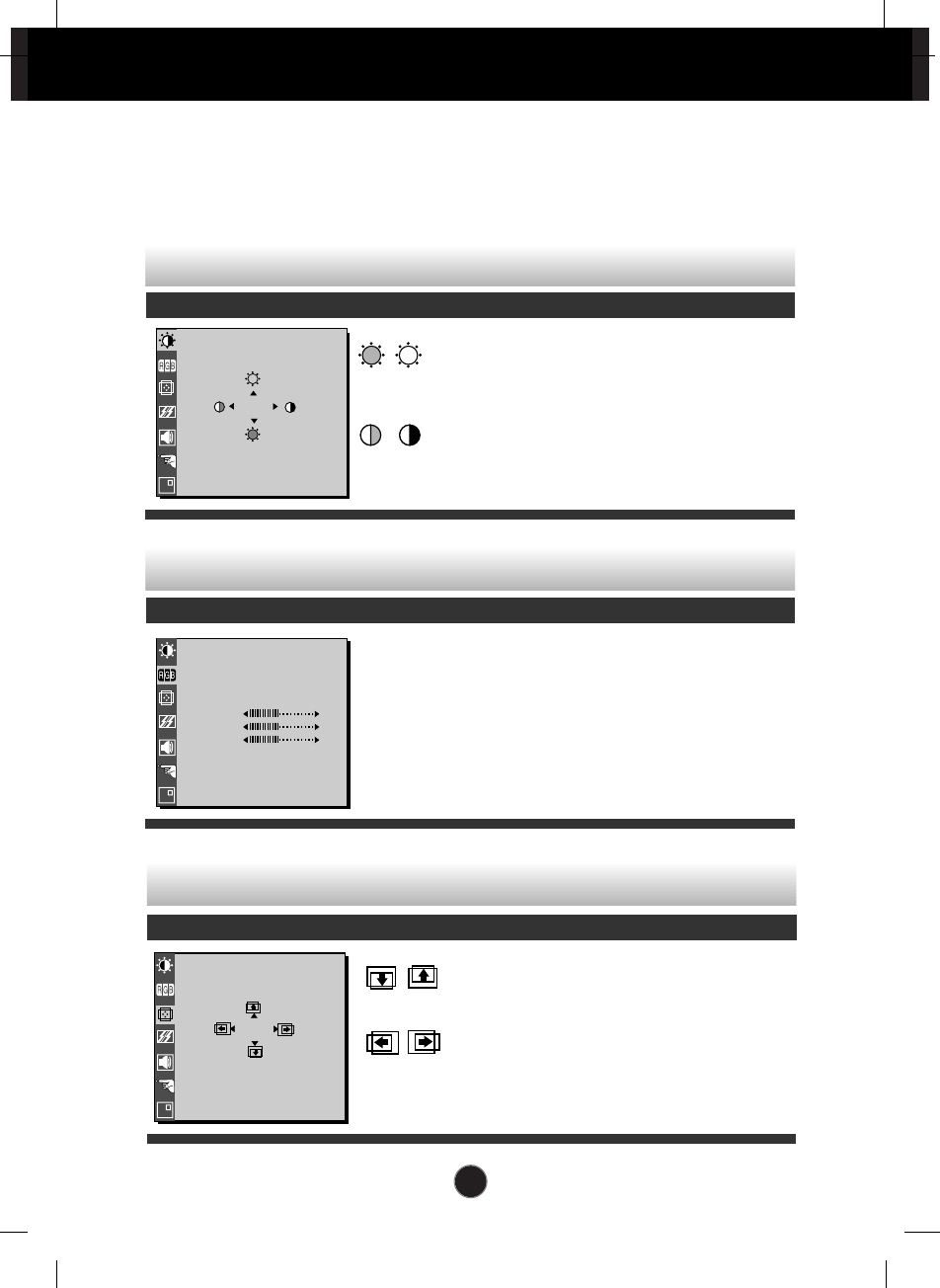
A11
On Screen Display(OSD) Selection and Adjustment
You were introduced to the procedure of selecting and adjusting an item
using the OSD system. Listed below are the icons, icon names, and icon
descriptions of the all items shown on the Menu.
OSD Adjust Description
BRIGHTNESS
To adjust the brightness of the screen.
CONTRAST
To adjust the contrast of the screen.
Vertical Position
To move image up and down.
Horizontal Position
To move image left and right.
To adjust the brightness and contrast of the screen
To adjust the position of the screen
OSD Adjust Description
BRIGHTNESS / CONTRAST
88
100
COLOR
PRESET 9300K 6500K
RED
GREEN
BLUE
POSITION
61
39
PRESET
RED
GREEN
BLUE
9300K/6500K
Select the screen color.
• 9300K: Slightly bluish white.
• 6500K: Slightly reddish white.
Set your own color levels.
To customize the color of the screen
OSD Adjust Description
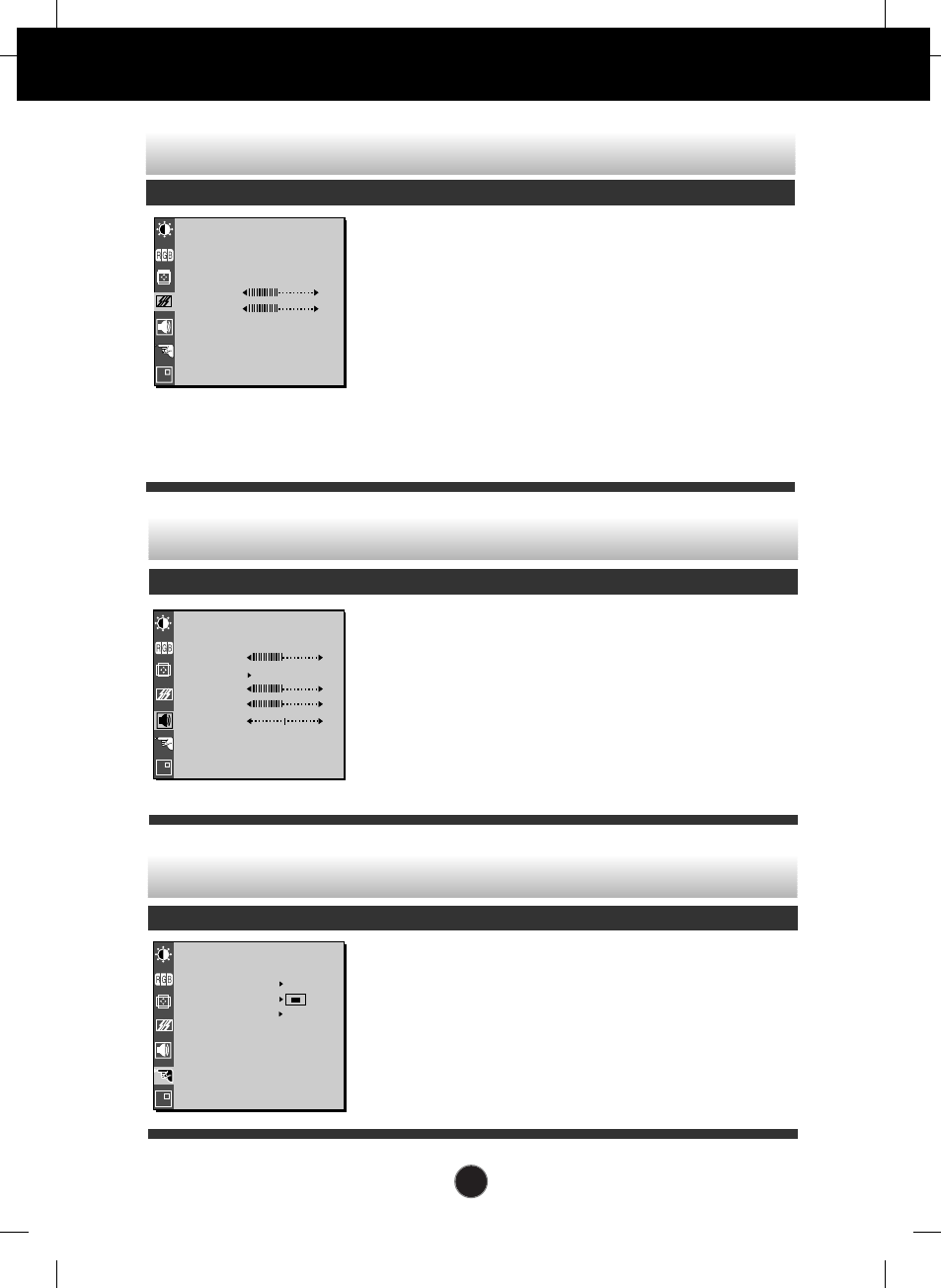
A12
On Screen Display(OSD) Selection and Adjustment
To improve the clarity and stability of the screen
OSD Adjust Description
To customize the screen status for a user's operating environment
OSD Adjust Description
To choose the language in which the
control names are displayed.
To adjust position of the OSD window
on the screen.
ELAPSED TIME
To display the use time of display.
LANGUAGE
OSD POSITION
To adjust the audio function
OSD Adjust Description
To decrease or increase volume level.
Used to select mute on (means sound off)
and mute off (means sound on).
To raises or lowers Bass level.
To raises or lowers Treble level.
To adjust the balance level.
VOLUME
MUTE
BASS
TREBLE
BALANCE
This function is suitable for analog signal
input only. This button is for the automatic
adjustment of the screen position, clock
and phase.
To minimize any vertical bars or stripes
visible on the screen background.The
horizontal screen size will also change.
To adjust the focus of the display. This
item allows you to remove any horizontal
noise and clear or sharpen the image of
characters.
AUTO
CLOCK
PHASE
TRACKING
AUTO YES NO
CLOCK
PHASE
AUDIO
OFF
MUTE
VOLUME
TREBLE
BASS
BALANCE
SETUP
LANGUAGE ENGLISH
0 H
ELAPSED TIME
OSD POSITION
1024x768/60Hz
PRESET MODE
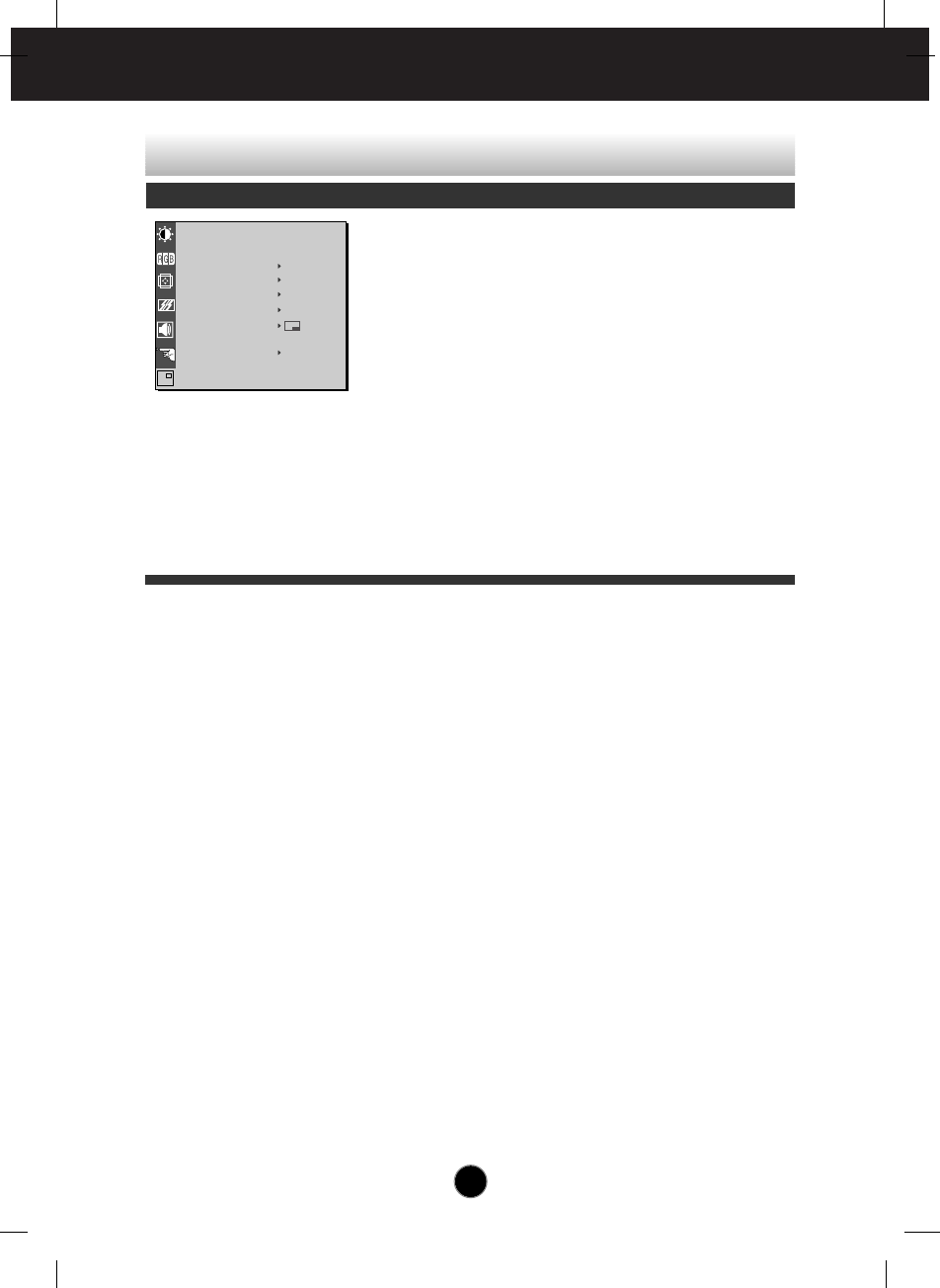
On Screen Display(OSD) Selection and Adjustment
A13
To adjust the PIP of the screen
OSD Adjust Description
This PIP (Picture-in-Picture) function allows the image
from the TV, VCR or DVD to be displayed on a sub-
screen while you are using a computer.
PIP ON/OFF
PIP
SOURCE
PIP SIZE
PIP
SOUND
PIP
POSITION
TRANSPARENCY
To select the sub-screen on/off.
To select an input signal for PIP.
To adjust the size of the PIP screen:
SMALL/LARGE
To turn the PIP sound on/off.
To adjust the position of PIP screen.
To adjust the transparency of the OSD
menu screen.
PIP
PIP ON/OFF OFF
TRANSPARENCY 0
PIP SOURCE TV
PIP SIZE SMALL
OFF
PIP SOUND
PIP POSITION
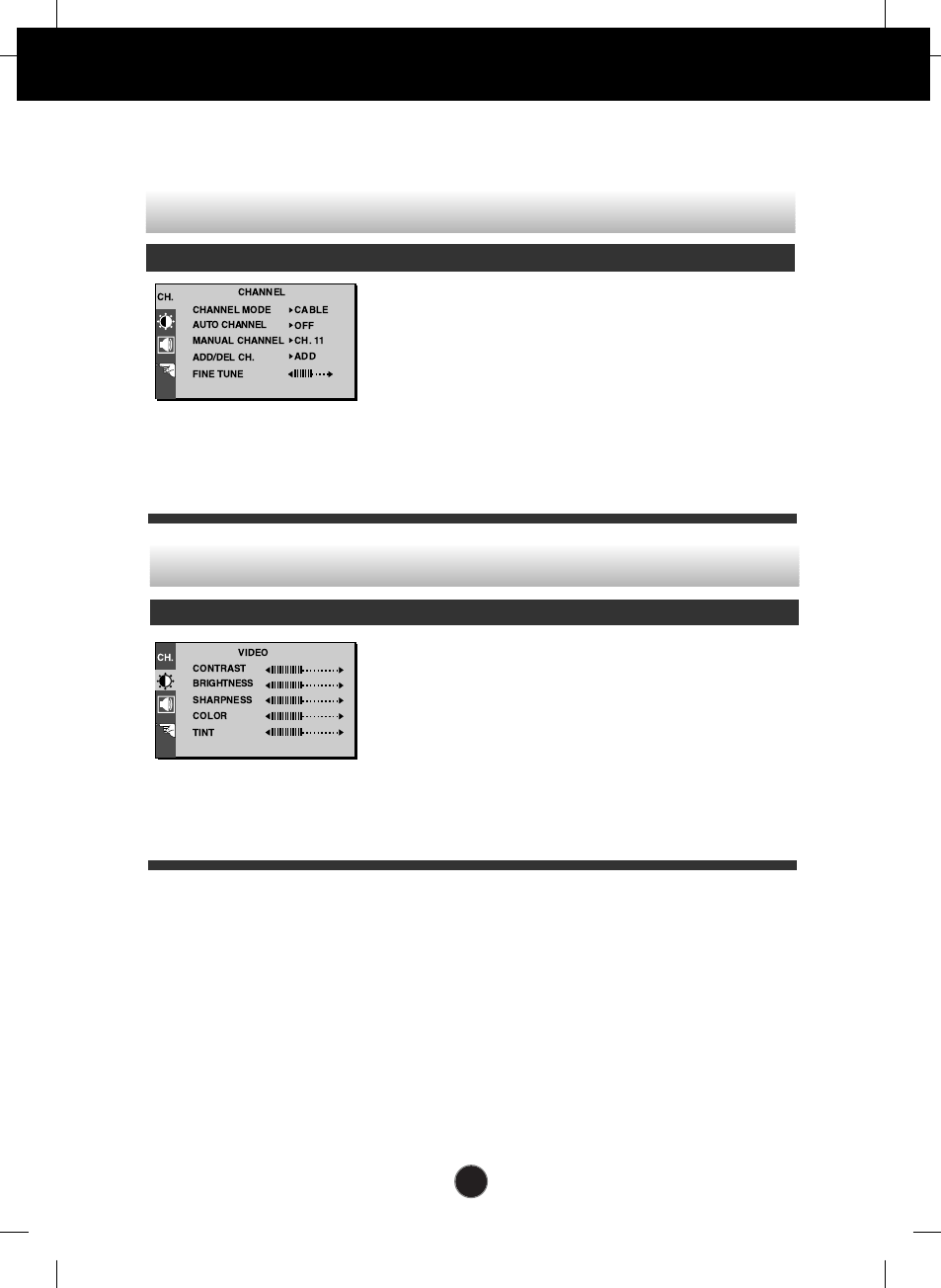
A14
On Screen Display(OSD) Selection and Adjustment
To select TV channel settings and adjust the channel quality
OSD Adjust Description
To select the channel reception type.
: AIR/CABLE
To automatically search the available
channels.
To change the channel.
To add/delete the selected channels.
To adjust the channel quality.
CHANNEL
MODE
AUTO
CHANNEL
MANUAL
CHANNEL
ADD/DELL
CH.
FINE TUNE
To adjust the screen when using the VCR/DVD/TV
To improve the clarity and stability of the screen
OSD Adjust Description
To adjust the contrast of the screen.
To adjust the brightness of the screen.
To adjust the clearness of the screen.
To adjust the color to desired level.
To adjust the tint to desired level.
This function is available only in NTSC
broadcasting mode.
CONTRAST
BRIGHTNESS
SHARPNESS
COLOR
TINT
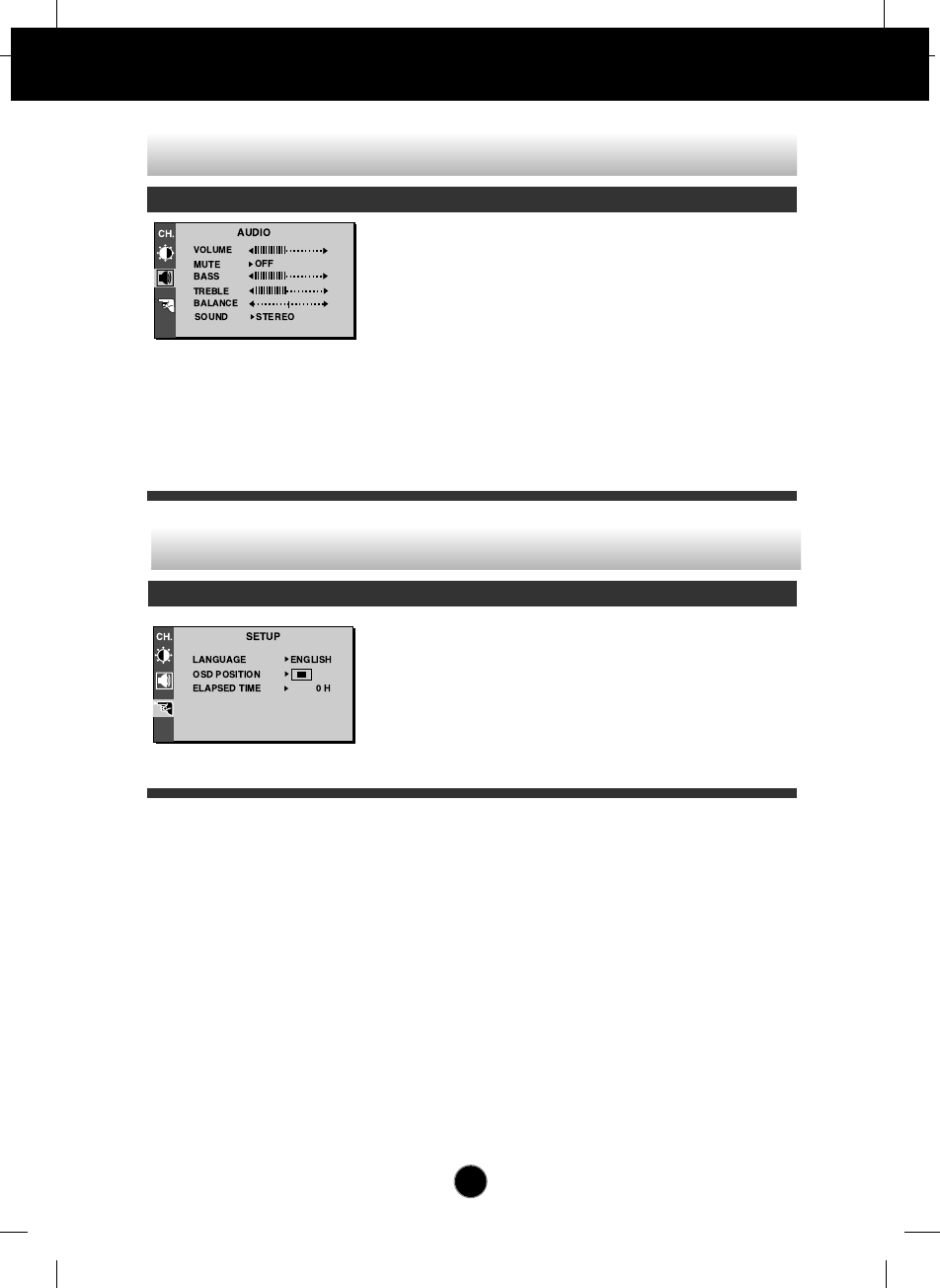
On Screen Display(OSD) Selection and Adjustment
A15
To adjust the audio function
OSD Adjust Description
To decrease or increase volume level.
Used to select mute on (means sound off)
and mute off (means sound on).
To decrease or increase bass level.
To decrease or increase treble level.
To adjust the balance level.
To select the audio mode.
: MONO/STEREO
VOLUME
MUTE
BASS
TREBLE
BALANCE
SOUND
To customize the screen status for a user's operating environment
OSD Adjust Description
To choose the language in which the
control names are displayed.
To adjust position of the OSD window
on the screen.
ELAPSED TIME
To display the use time of display.
LANGUAGE
OSD POSITION
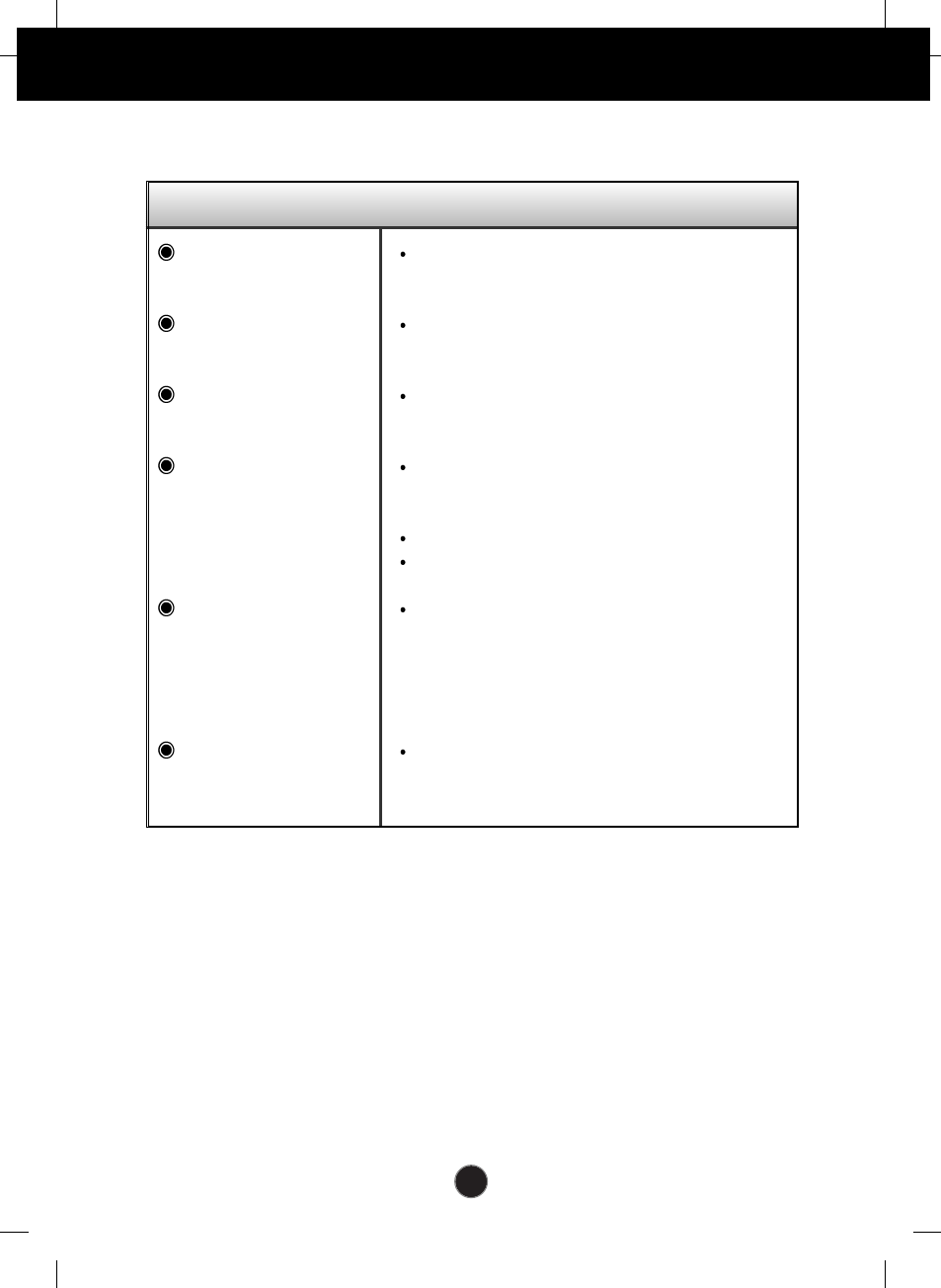
A16
Troubleshooting
No image appears
Check the following before calling for service.
No image appears
Is the power cord of the
display connected?
Is the power indicator
light on?
Is the power on and the
power indicator green?
Is the power indicator
amber?
Do you see an "OUT
OF RANGE" message
on the screen?
Do you see a "CHECK
SIGNAL CABLE "
message on the
screen?
Check and see if the power cord is connected
properly to the power outlet.
Press the Power button.
Adjust the brightness and the contrast.
If the display is in power saving mode, try moving
the mouse or pressing any key on the keyboard
to bring up the screen.
Make sure if the power is on.
Try to turn on the PC.
This message appears when the signal from the
PC (video card) is out of horizontal or vertical
frequency range of the display. See the
'Specifications' section of this manual and
configure your display again.
This message appears when the signal cable
between your PC and your display is not
connected. Check the signal cable and try again.
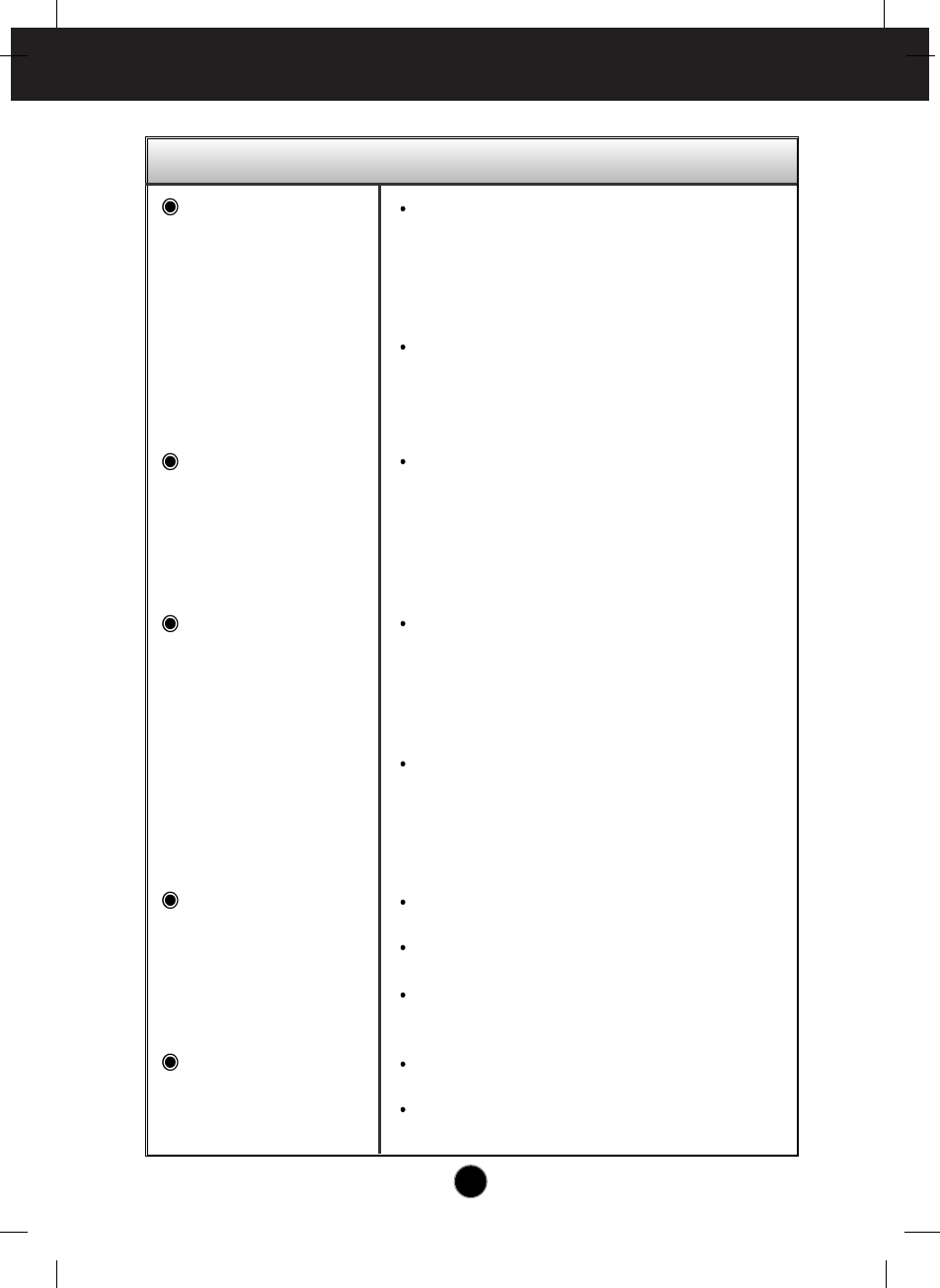
Troubleshooting
A17
Display image is incorrect
Display Position is
incorrect.
On the screen
background, vertical
bars or stripes are
visible.
Any horizontal noise
appearing in any
image or characters
are not clearly
portrayed.
The screen color is
mono or abnormal.
The screen blinks.
Press the AUTO/SELECT button to
automatically adjust your display image to the
ideal setting.
If the results are unsatisfactory, adjust the image
position using the H position and V position
icon in the on screen display.
Check Control Panel --> Display --> Settings
and see if the frequency or the resolution were
changed. If yes, readjust the video card to the
recommend resolution.
Press the AUTO/SELECT button to
automatically adjust your display image to the
ideal setting.
If the results are unsatisfactory, decrease the
vertical bars or stripes using the CLOCK icon in
the on screen display.
Press the AUTO/SELECT button to
automatically adjust your display image to the
ideal setting.
If the results are unsatisfactory, decrease the
horizontal bars using the PHASE icon in the on
screen display.
Check Control Panel --> Display --> Settings
and adjust the display to the recommended
resolution or adjust the display image to the ideal
setting. Set the color setting higher than 24 bits
(true color).
Check if the signal cable is properly connected
and use a screwdriver to fasten if necessary.
Make sure the video card is properly inserted in
the slot.
Set the color setting higher than 24 bits (true
color) at Control Panel - Settings.
Check if the screen is set to interlace mode and if
yes, change it to the recommend resolution.
Make sure the power voltage is high enough, It
has to be hgher than AC100-240V 50/60Hz.
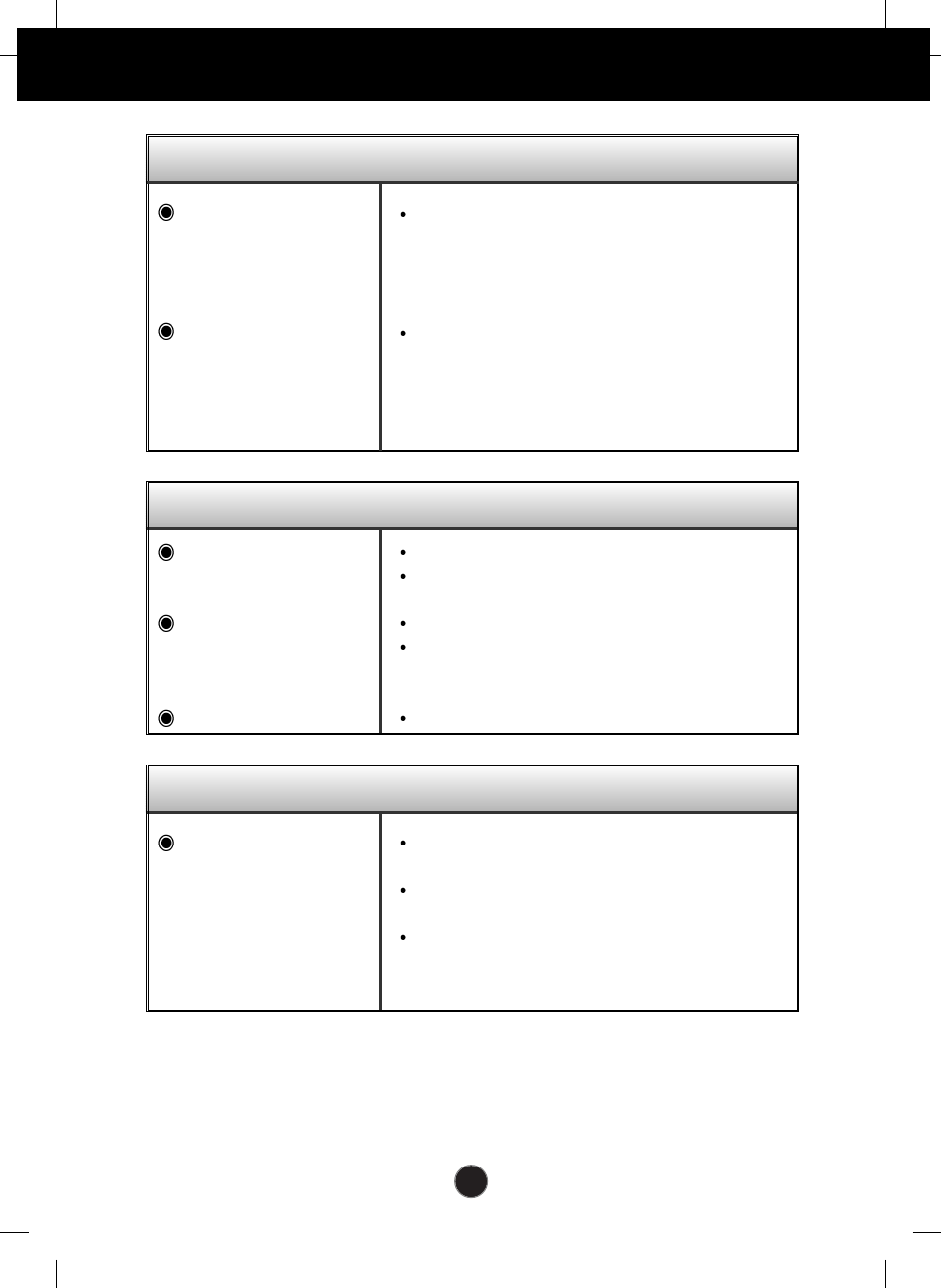
A18
Troubleshooting
Have you installed the display driver?
Have you installed the
display driver?
Do you see an
"Unrecognized monitor,
Plug&Play (VESA DDC)
monitor found"
message?
Be sure to install the display driver from the
display driver CD (or diskette) that comes with
your display. Or, you can also download the
driver from our web site: http://www.lge.com.
Make sure to check if the video card supports
Plug&Play function.
TV function
TV signal is not
received.
Check the channel system and make sure you
chose the correct channel system.
Check the AUTO CHANNEL function to
automatically search the available channels.
Check and see if the TV adapter is properly
connected between your display and antenna
cable.
Audio function
Check if the audio cable is correctly connected.
Check the volume level.
Adjust the TREBLE to an appropriate level.
Adjust the BASS to an appropriate level.
Check the volume level.
No sound.
Sound is too high
pitched or too low
piched.
Sound level is too low.

A19
Specifications
NOTE
Information in this document is subject to change without notice.
15 inches (38.1cm) Flat Panel Active matrix-TFT LCD
Anti-Glare coating
15 inches viewable
0.3 mm pixel pitch
Horizontal Freq. 30 - 63kHz (Automatic)
Vertical Freq. 56 - 75Hz (Automatic)
Input Form Separate TTL, Positive/Negative
Signal Input 15 pin D-Sub Connector
Input Form RGB Analog (0.7Vp-p/75ohm)
Max VESA 1024 x 768@75Hz
Recommend VESA 1024 x 768@60Hz
DDC 2B
Input PC : 700mVrms
TV:100%modulation
Video : 400mVrms
Audio output and its ratio
1W + 1W (left+right)/10%
Speaker Impedance 8Ω
Normal :
30W
Stand-by/Suspend
≤5W
DPMS Off ≤ 5W
Width 36.02 cm / 14.18 inches
Height 35.98 cm / 14.17 inches
Depth 15.30 cm / 6.02 inches
Net 4.15 kg (9.15 lbs)
Tilt -5˚~30˚
AC 100-240V 50/60Hz 0.6A
Operating Conditions
Temperature 10˚C to 35 ˚C
Humidity 10 % to 80 % non-Condensing
Storage Conditions
Temperature -20˚C to 60 ˚C
Humidity 5 % to 95 % non-Condensing
Attached( ), Detached ( O )
Attached( ), Detached ( O )
Wall-outlet type or PC-outlet type
TCO99
Display
Sync Input
Video Input
Resolution
Plug&Play
Audio Signal
Power
Consumption
Dimensions
&Weight
(with tilt stand)
Tilt Range
Power Input
Environmental
Conditions
Tilt Stand
Signal cable
Power cord
Regulations
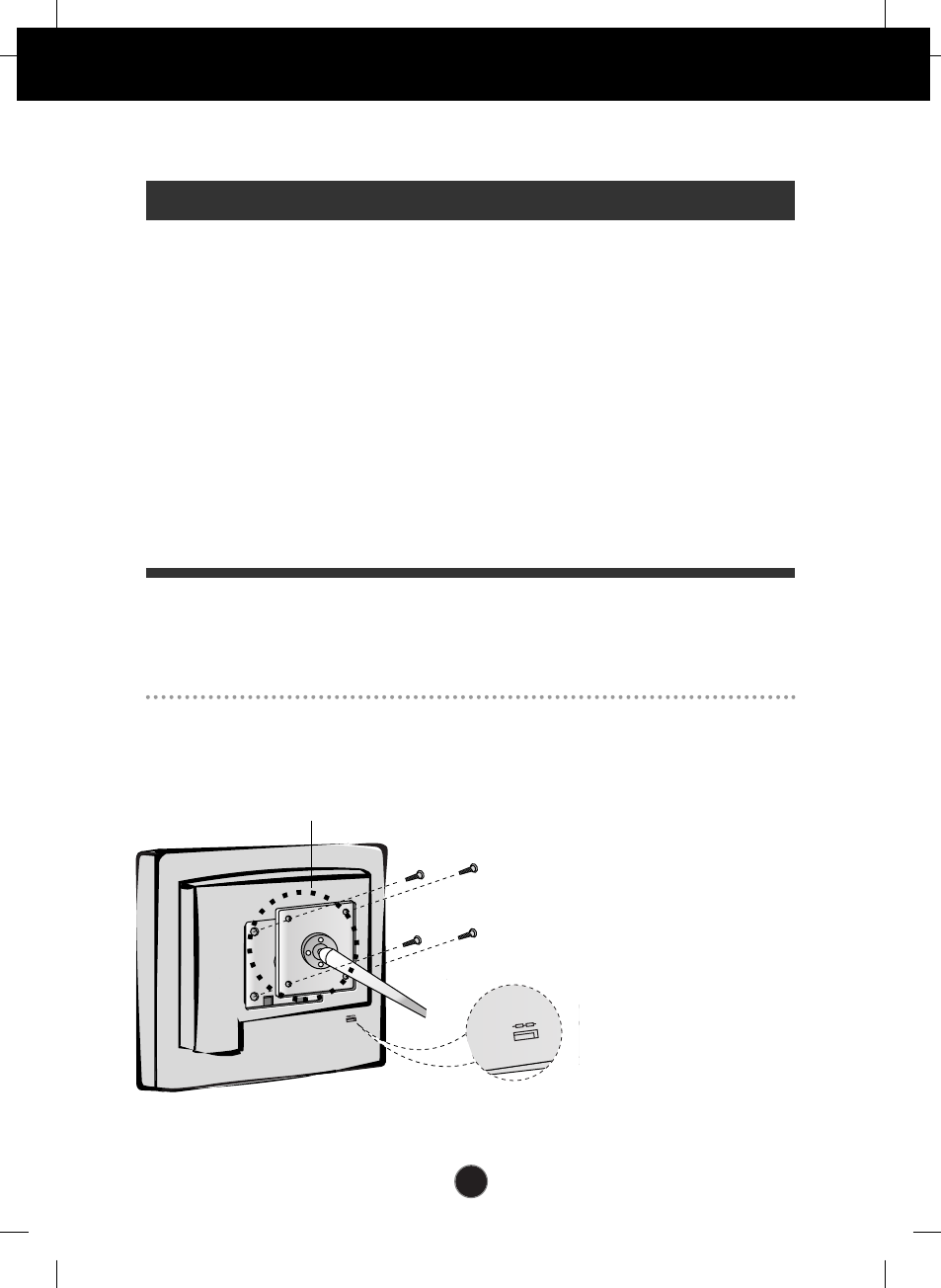
A20
Specifications
Preset Modes (Resolution)
Display Modes (Resolution) Horizontal Freq. (kHz) Vertical Freq. (Hz)
1
2
3
4
5
6
7
8
9
10
11
*12
13
14
* Recommended
Unlike CRT monitors, which require a high refresh rate to minimize flickering, TFT
technology is inherently flicker-free. If possible, configure your computer for 1024 x 768
addressability at 60Hz vertical refresh rate.
640 x 350
720 x 400
640 x 480
640 x 480
640 x 480
640 x 480
800 x 600
800 x 600
800 x 600
800 x 600
832 x 624
1024 x 768
1024 x 768
1024 x 768
31.468
31.468
31.469
35.000
37.861
37.500
35.156
37.879
48.077
46.875
49.725
48.363
56.476
60.023
70
70
60
66.67
72.8
75
56.25
60
72
75
75
60
70
75
VGA
VGA
VGA
VESA
VESA
VESA
VESA
VESA
VESA
VESA
MAC
VESA
VESA
VESA
VESA wall mounting
Connected to another object (stand
type and wall-mounted type. This
monitor accepts a VESA-compliant
mounting interface pad.)
Kensington Security Slot- optional
Connected to a locking
cable that can be purchased
separately at most computer
stores
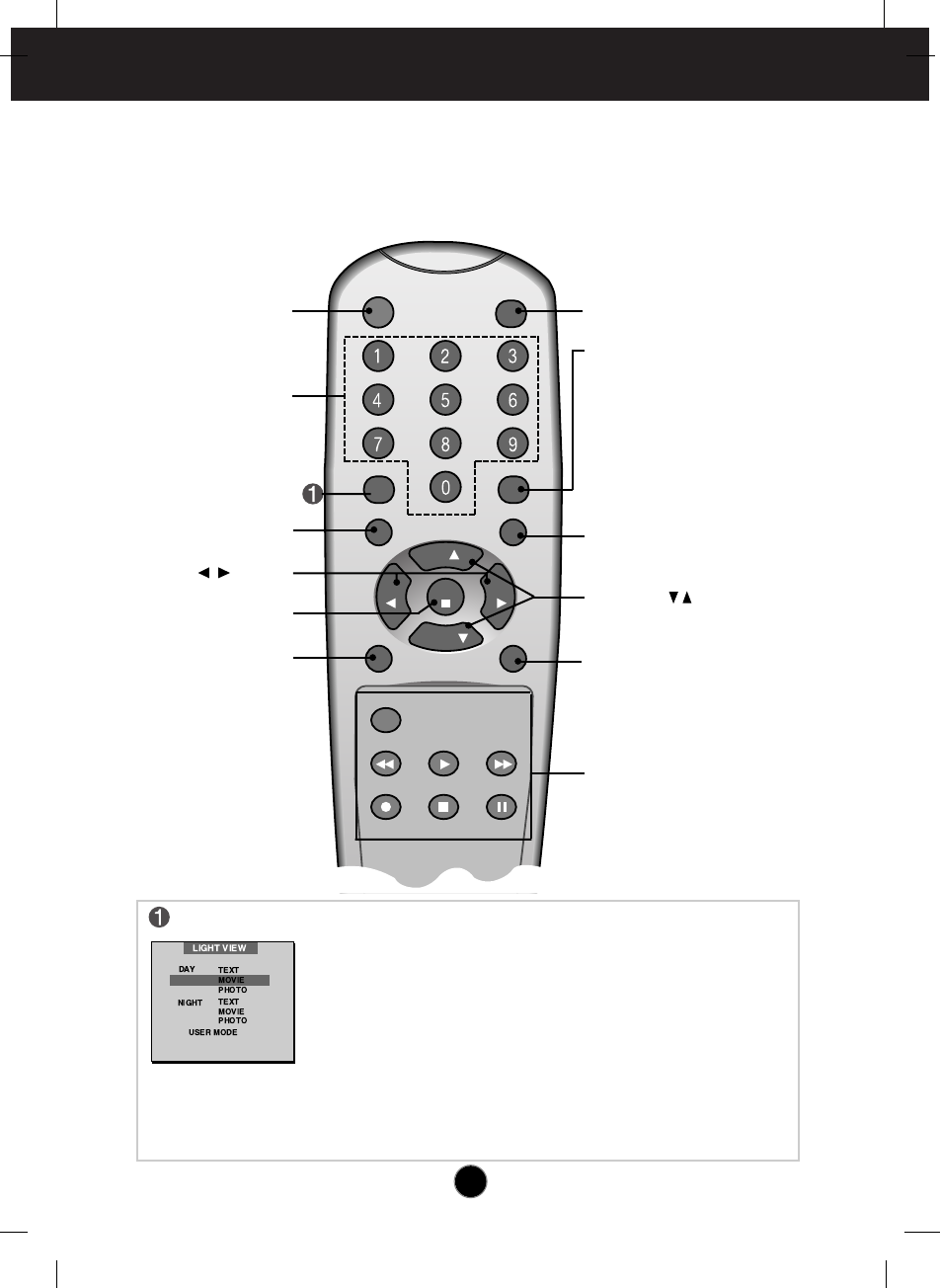
Using the Remote Control
A21
PIP
POWER
REW PLAY FF
REC STOP
P/STILL
*
POWER
APC
MENU
SOURCE
UP
VOL VOL
SET
DOWN
MUTE
AUTO
Remote Control
For detailed instructions of each button on the remote control, refer to the
appropriate pages of this manual.
MENU Button
VOLUME( ) Buttons
SET Button
SOURCE Selection
Button
AUTO Button
•
This function is to automatically
search the available channels. It is
available to the TV signal inputs only.
•
This function is to automatically adjust
your display image to the ideal settings
for the current screen resolution size
(display mode). It is available to the PC
signal inputs only.
MUTE Button
To select mute on or off.
DOWN/UP ( )
Buttons
VCR Buttons
These buttons are available for
LG VCR remote controls only.
Refer to the Owner’s Manual for
your VCR .
Power Button TV/AV Button
PIP Button
The sub-screen is changed in the order
shown below.
: SMALL -> LARGE -> OFF
Number buttons
LIGHT VIEW
This function optimizes the brightness, contrast or color value
to the surrounding conditions and settings and enables you to
enjoy the most suitable picture by adjusting the surroundings
(DAY/NIGHT/USER MODE).
•
TEXT: For viewing letters
•
MOVIE: For viewing movies
•
PHOTO: For viewing pictures or the photographs
•
USER MODE: This function memorizes the manual
adjustment -Brightness, Contrast and Color value on the
On Screen Display.
* You can use this function only with the remote control.
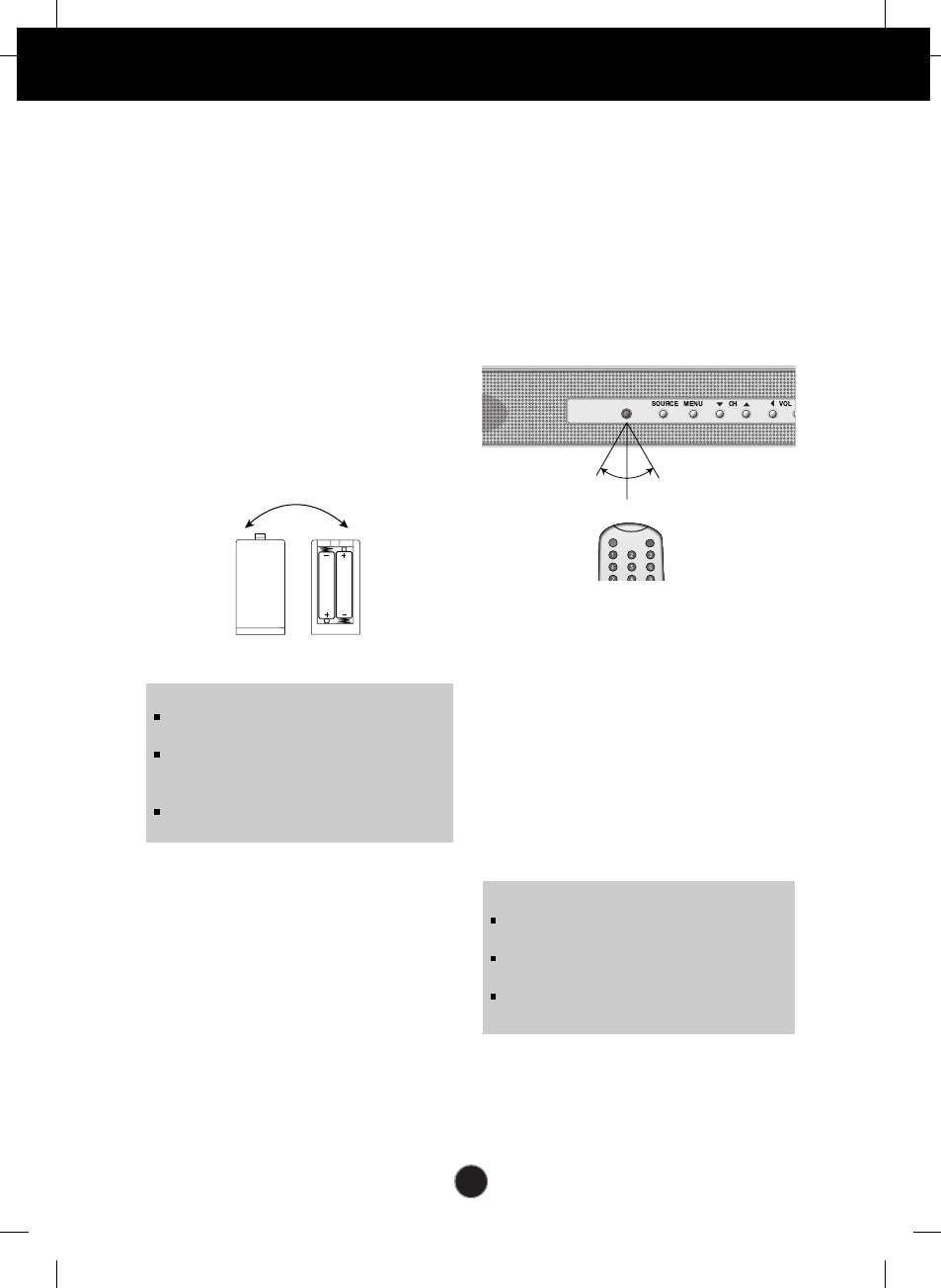
A22
Using the Remote Control
Insert the batteries into the remote
control to operate the monitor.
Preparing the Remote
Control
1. Open the battery cover.
2. Insert batteries (AAA size).
Make sure to match the + and -
on the batteries to the marks
inside the battery compartment.
3. Close the cover.
AAA
AAA
This section shows you how to use
the remote control.
Operating with the Remote
Control
Point the remote control at the remote
sensor and press the buttons.
Distance : About 23 ft (7 m) from the
front of the remote sensor.
Angle : About 30° in each direction
of the front of the remote
sensor.
Do not expose the sensor of remote
control in the monitor to a strong light
source such as direct sunlight or
illumination. If so, may not be able to
operate the monitor with the remote
control.
30°30°
*
POWER
Note
Do not drop the remote control or handle it
roughly.
Do not leave the remote control in extremely hot
or humid conditions.
Do not expose the remote control to water or
anything wet.
Note
Do not insert the batteries into the remote
control in the wrong direction.
Do not charge, heat, open, or short-circuit the
batteries. Also do not throw the batteries into
the fire.
Do not use different types of batteries together,
nor mix old and new batteries.
Within about 23ft (about 7m)
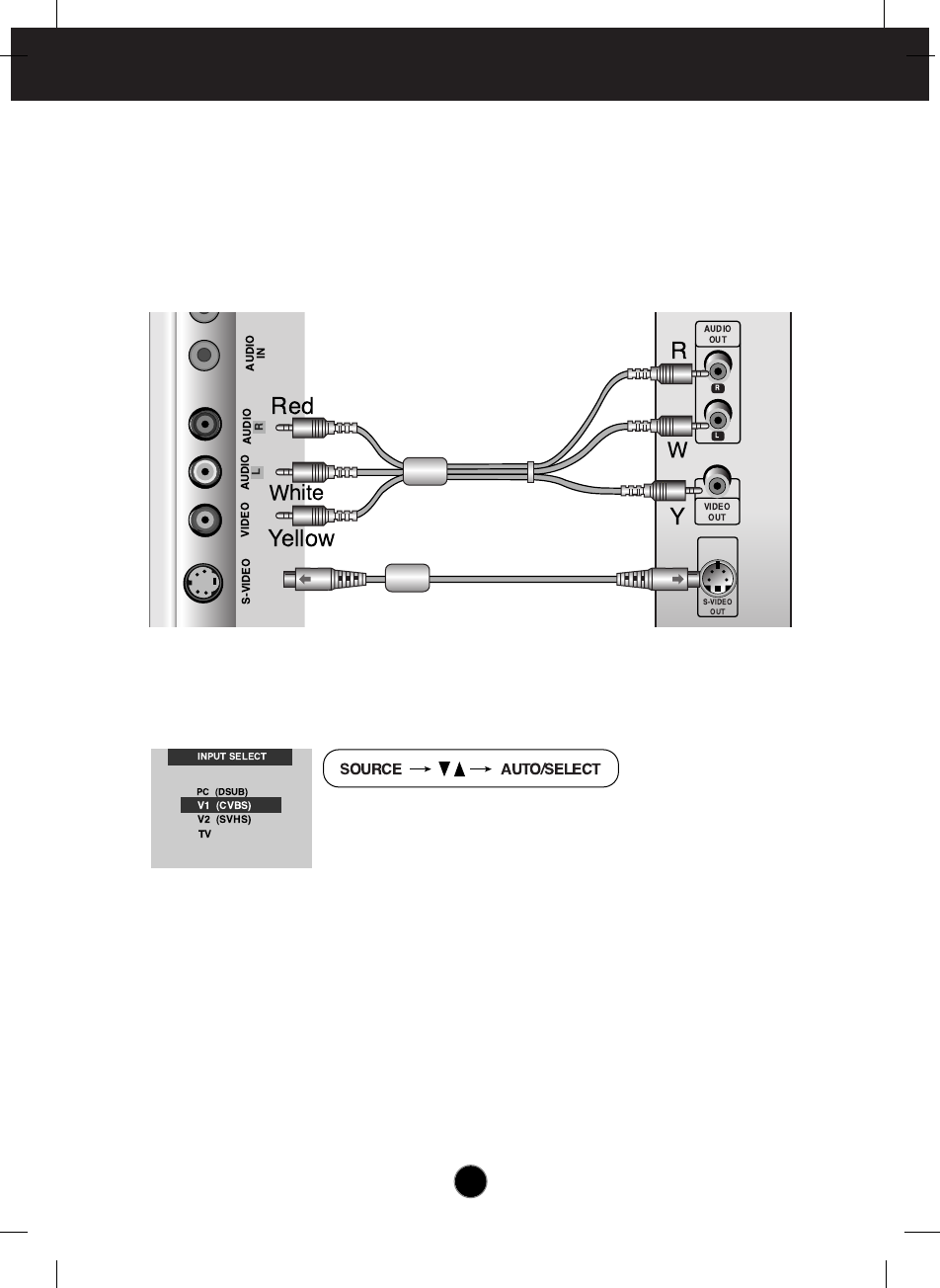
Connection of external equipment
A23
• VCR/DVD
Connecting the VCR/DVD
1. Connect the each audio/video output jack of the VCR/DVD to the
corresponding input port as shown on the Display.
If you connect the S-Video input port to external equipment, you can have an
improved definition image.
2. Select an input signal.
Press the SOURCE button on the front panel of the display
to select an input.
• V1(CVBS): Composite video
• V2(SVHS): S video
• Display
S-Video cable
RCA cable
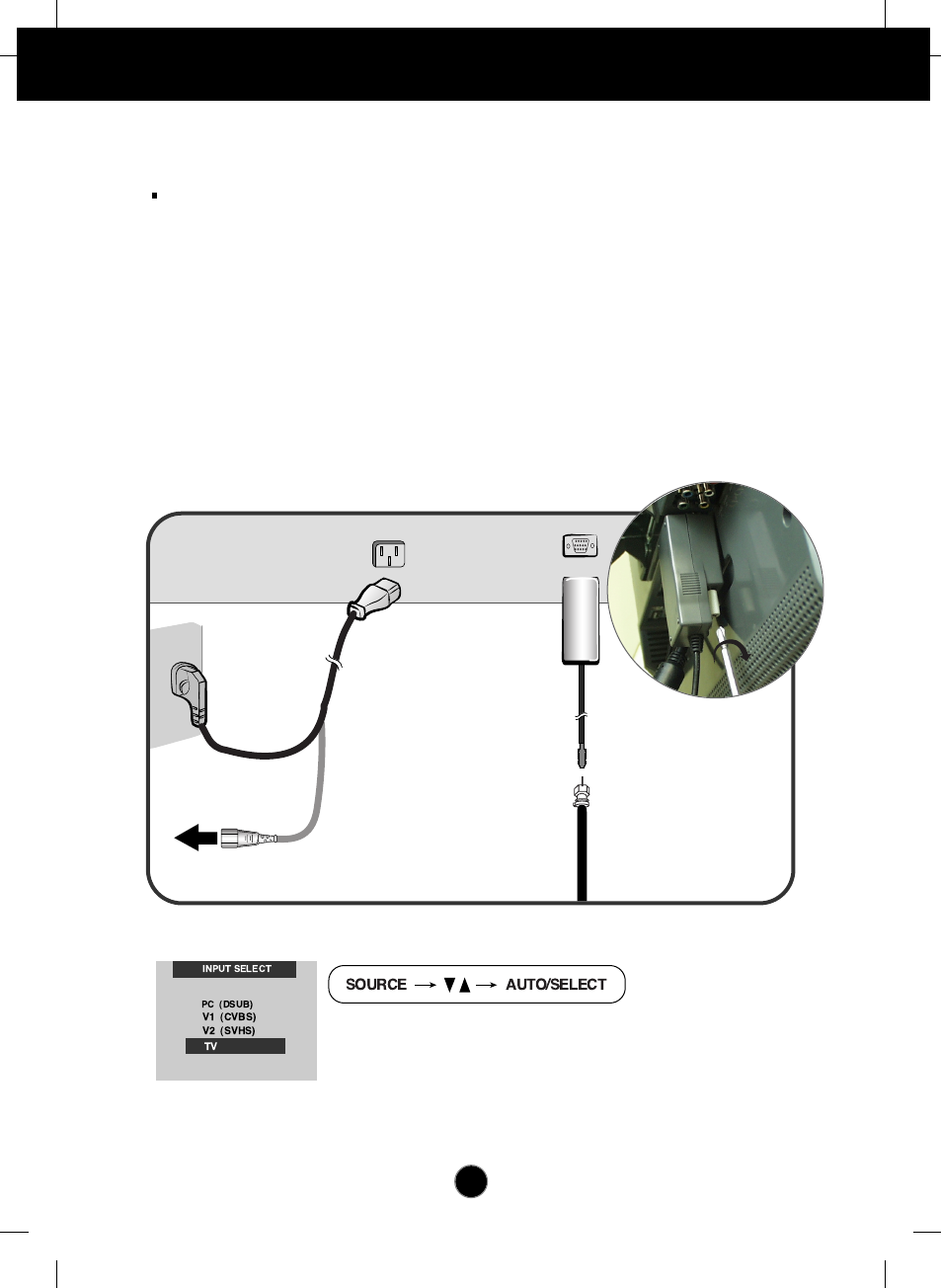
A24
Connection of external equipment
Watching TV- Optional
Before setting up the monitor, ensure that the power to the monitor, the
computer system, and other attached devices is turned off.
1. As you see in the picture, connect the TV tuner pack to the monitor and use
your hand or a screwdriver to fasten the thumbscrews. And then connect the
antenna to the TV tuner pack.
(a) TV tuner pack (Optional):
L1510T model includes TV tuner pack.
For L1510A models, TV tuner can be purchased as an option from the LGE
monitor dealers.
2. Connect the power cord into a proper power outlet that is easily accessible and
close to the display
Wall-outlet type*
PC-outlet type*
(a)
Antenna
(Optional)
(a)
TV Tuner
pack
(Optional)
Use a minus or a plus
screwdriver to fasten
the bolt to the arrow
direction.
4. Select an input signal.
Press the SOURCE button on the front panel of the display
to select an input.
• TV: TV